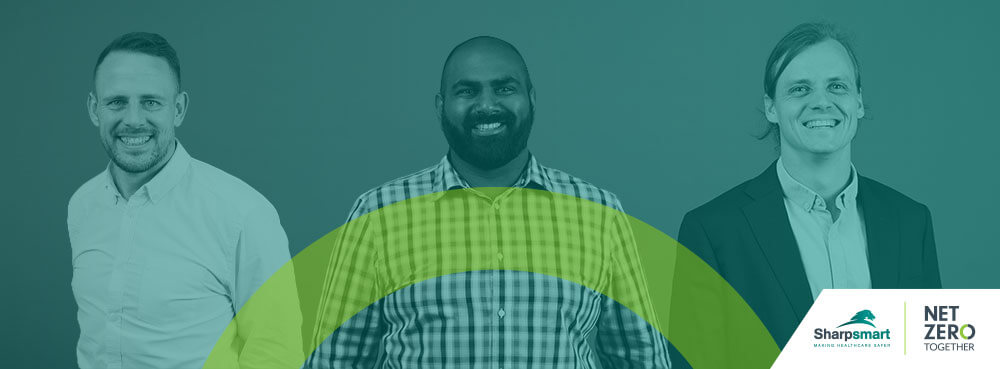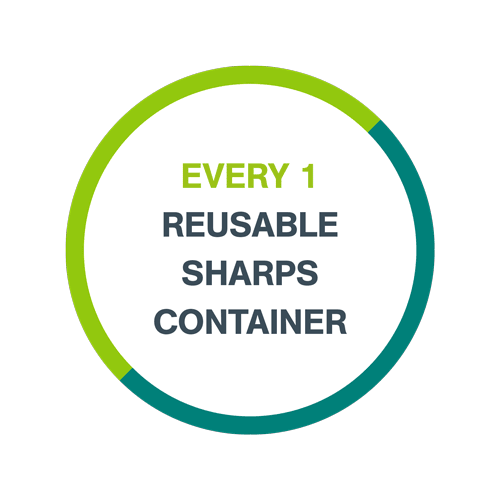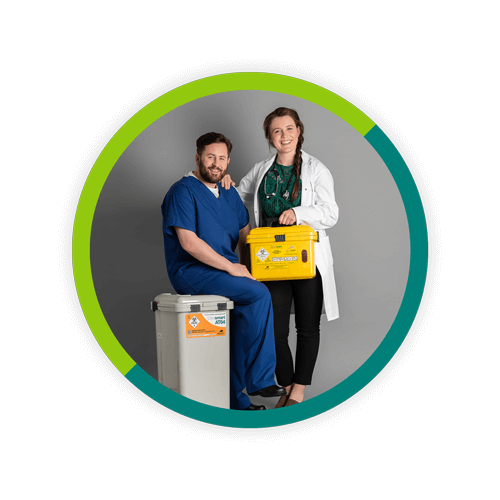Expert Tips for Hospitals on the Route to Net Zero

The route to Net Zero is paved with green intentions… or something like that… A 2040 target for achieving net zero carbon emissions is an ambitious one, and no one expects it to be easy. Especially not for hospitals. But to make it slightly easier and offer a little guidance, we’ve sought the advice of a handful of our sustainability experts to round up some helpful tips for hospitals on the route to Net Zero. We want to do all we can to achieve Net Zero, together.
Our Experts and Their Topics:
- Phil Steer – Auditing, optimising, and keeping track.
- Sumal Karunaratne – Planning ahead and taking advantage.
- Guy Wing – Being data-driven with peer-reviewed information.

Phil Steer – Auditing, Optimising, and Keeping Track
“Use waste auditing as a means to identify exactly where you’re at so you can develop your waste strategy accordingly to ensure the best possible outcomes.”
Conduct Audits to Identify Gaps and Opportunities
By conducting a thorough audit, you can establish a baseline analysis to understand your organisation’s current performance and identify where carbon savings can be made. Auditing also allows you to develop a clear strategy to optimise your waste management across all of your waste streams.
Optimise Your Approach to Waste Management
After an audit, you can map out the departments within your facility to ensure the right bins are being placed in the most efficient areas for the waste produced - for example, placing offensive waste bins in treatment rooms. An act as simple as ensuring the right bags are in the right bins in the right places makes it easy for staff, patients and visitors to dispose of waste correctly. By following these steps and establishing best practices throughout your organisation with training and education, you’ll be on track for achieving or even exceeding the 20-20-60 waste split target.
Keep Track of Everything and Report Accurately
Keeping track of your waste and what’s happening with it using on-site tracking software aids both compliance, and carbon reduction. You’ll be able to see the busiest times and areas and how frequently bins are being emptied, giving you the ability to schedule your resources more efficiently. Tracking is only one side of the coin though, as well as understanding the journey of your waste from generation to final disposal, you’ll also need to report on all clinical waste generated using accurate data in line with the NHS Clinical Waste Strategy. Having access to accurate data is imperative for keeping on track with your environmental performance and achieving your sustainability goals.
“You might benefit from a waste policy rewrite and strategy development to enable you to move more items up the waste hierarchy – switching waste operations from being disposal-focused to being carbon-conscious on your route to Net Zero.”

Sumal Karunaratne – Planning Ahead and Taking Advantage
“Understand your organisation, your sites, and the waste you’re producing so you can benchmark effectively and set realistic and achievable targets – it’s possible to exceed to 20-20-60 waste split.”
Plan Ahead When Purchasing Replacements
If you identify what electricals you’re throwing away and their energy ratings, you can easily track carbon efficiencies between them and the replacements you’re purchasing. It’s worth establishing a mandatory procurement standard for items such as fridges, dishwashers, washing machines, microwaves, and vacuum cleaners to be AAA+ energy-efficient appliances from reliable brands.
Be Conscious Not to Overlook Food Waste
Implementing methods to measure and reduce food waste can make a drastic difference – from prep waste and spoilage to unserved meals and plate waste. But you first need to know what’s being wasted so you can optimise your approach. There are some quick wins such as introducing meat-free days in hospital restaurants, providing healthy lower carbon alternatives like plant-based meals and using seasonal ingredients. Consider introducing support to help staff reduce food waste and avoid food poverty, and installing technology to process your food waste – macerator, biodigester, composting technology, etc. Tracking food miles, consumption patterns and disposal of food and drink products for staff and patients will also offer a lucrative source of data – are the same food types or meals producing consistently large waste volumes? They may be worth removing from your menu…
Take Advantage of New Technologies
There are various technologies you can use to eliminate waste to landfill and even reduce what you send to Waste-from-Energy plants by increasing reuse and recycling. Always look at full back-end disposal processes to ensure you’re receiving the most sustainable solutions. If you’re not benefitting from carbon-efficient disposal methods for each waste stream, it’s worth reviewing your options. Remember, high-temperature incineration is the highest carbon output disposal process for your waste.
“It’s imperative to identify your waste and how much you’re producing so you can set realistic benchmarks and targets – you also need to understand where it’s going once it leaves your site for disposal to ensure the most sustainable outlets on your route to Net Zero.”

Guy Wing – Being Data-Driven With Peer-Reviewed Information
“My biggest piece of advice would be that any decisions you’re making should be data-driven and based on open-source and peer-reviewed information.”
Taking a slightly different approach to this topic, here are two key resources that can prove helpful for hospitals on the route to Net Zero:
The Healthcare LCA Database
HealthcareLCA is a platform that brings together environmental assessments of health systems, hospitals, healthcare services, surgical procedures, medical equipment, and pharmaceuticals into a comprehensive open-access database. It’s an invaluable resource for anyone seeking up-to-date information on the environmental footprint of various facets of healthcare. It simplifies the process of accessing vital research and makes it easier for users to explore and analyse the information. This platform is freely available to anyone interested in healthcare-related life cycle assessments and serves as an educational tool – raising awareness among healthcare professionals about the environmental impacts of healthcare practices.
The NHS Emission Quantification Recipe Book
This NHS Emissions Quantification Recipe Book is a collaborative solution for establishing a standardised approach to calculating emissions associated with the NHS Carbon Footprint and Carbon Footprint Plus themes. This recipe book aims to provide transparency, collaboration and evidence-based methodologies, recognising that different NHS organisations are at various stages in calculating and quantifying their emissions. It can serve as a vital resource for NHS organisations striving to measure their carbon footprint. A standardised approach will help the NHS effectively monitor progress, identify areas for improvement, and work towards a greener and more sustainable future in healthcare.
“Having free, open access to databases and platforms that enable you to analyse life cycle assessments and work with standardised data sets for measuring your carbon impact will give you a huge advantage on your route to Net Zero.”
From Sharpsmart
“Always looks at the full life cycle of a product or service you’re considering, and implement the waste hierarchy to serve as your framework guide from the procurement stage.”
 Reuse or Recycle?
Reuse or Recycle?
There’s no denying the environmental benefits of recycling and using recycled materials wherever possible, but when it comes to single-use products made from recycled materials, they still get incinerated via high temperatures after a single use. Again looking to the waste hierarchy as a reference, reuse sits above recycle and there’s a simple explanation for that – it’s better. In fact, when it comes to looking at full life cycle assessments, we’ve got some helpful peer-reviewed research around reusable sharps containers – which for decades have been a solution for reducing single-use plastics and their associated greenhouse gas emissions.
The “Impact on Life-Cycle Carbon Footprint” study demonstrated that annually for every 100 beds you could:
- Reduce your carbon footprint by 11.2 tonnes of CO2e.
- Eliminate incineration of 3.1 tonnes of plastic.
- Eliminate the use of 0.5 tonnes of cardboard.
-
Eliminate the manufacture 5,837 single-use sharps containers.
Resources For Reducing Your Carbon Footprint
We’re huge advocates of a greener healthcare system and want to do everything we can to support hospitals in achieving their sustainability goals.
With that in mind, we don’t want you to leave this blog empty-handed, so here are some free resources to help you on your route to Net Zero.
“The 20-20-60 waste split is a target based on an ideal, by introducing Sharpsmart reusables you’ll be reducing emissions from incineration as well as plastic, enabling you to exceed that target and drive more sustainable outcomes on your route to Net Zero.”
S upporting Your Route to Net Zero
upporting Your Route to Net Zero
We’ve been dedicated to increasing sustainability and developing greener solutions in the healthcare waste industry for over 20 years – partnering with hospitals throughout the UK to significantly reduce carbon emissions with proven results. We take a partnership approach to waste management, offering consultancy and guidance within the four walls of your organisation to help you optimise your waste management processes for the best results. If you’d like support on your route to Net Zero, please don’t hesitate to get in touch.

